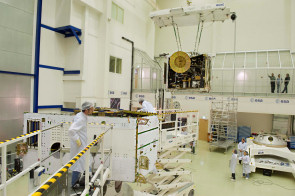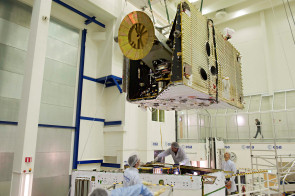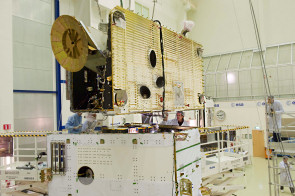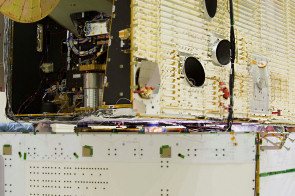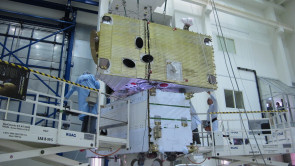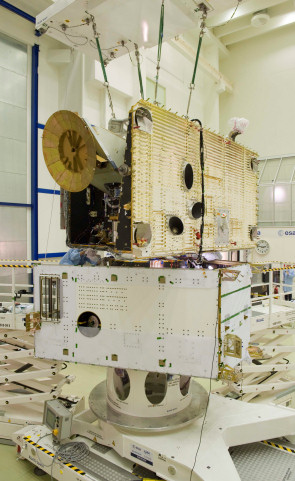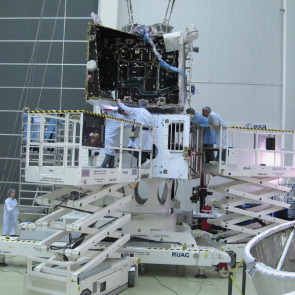#05: BepiColombo Planetary Orbiter and Transfer Module mated for first time
27 April 2012
The Structural and Thermal Models of the BepiColombo Mercury Planetary Orbiter and Mercury Transfer Module were mated for the first time on 11 April 2012. The mating was performed to accurately position the inter-module hardware on the transfer module.The harsh thermal environment that the BepiColombo Mercury Planetary Orbiter (MPO) will endure while in orbit around its target planet places special requirements on the mechanical interfaces between the orbiter and the other modules in the composite spacecraft stack that will launch and transfer to Mercury. Use of conventional interfaces would leave the mating surfaces exposed on the exterior of the MPO after separation; if these surfaces were exposed to intense solar radiation, they would transfer heat into the spacecraft structure.
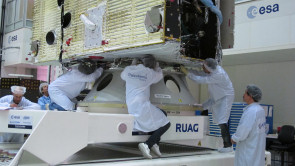 |
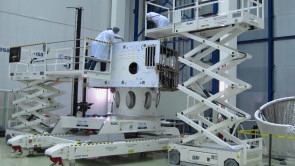 |
|
Preparations for the mating of the Mercury Planetary Orbiter (MPO; left) and the Mercury Transfer Module (MTM; right). (Click on the image for larger images and further details.) |
|
To prevent this, the non-explosive actuators that will separate the spacecraft from its companions in the composite stack are housed within the MPO. After separation, the Inter-Module Hardware (IMH) remains attached to the Mercury Transfer Module (MTM) and the Magnetospheric Orbiter Sunshield and Interface Structure (MOSIF), neither of which will enter orbit around Mercury. Deployable shields will cover the holes in the MPO thermal blanket through which the IMH was attached to the internal interfaces.
Complex mechanical interface
The mechanical interface between the MPO and the MTM is further complicated by the fact that the cup-and-cone separation interfaces inside the MPO will be inaccessible once the spacecraft is fully integrated. The small separation between the two spacecraft once they are mated also makes the interface more difficult to work on. The IMH addresses these problems by providing an additional cup-and-cone interface in the gap between the two spacecraft. Cup-and-cone interfaces, which consist of a conical cone that fits into a matching cup and a clamp band that 'pre-loads', or pushes together, the two halves of the interface, allow the transfer of mechanical loads in all planes while permitting easy and controlled mating and separation when the clamp band is removed. During final stack integration, the completed MPO will be lowered onto the MTM and the interfaces will be secured with the clamp bands. At this stage, the 'upper' (-Z) face of the MTM will be populated with equipment, so a specially designed tool will be used to tighten the clamp band fasteners.
The reason for the temporary mating of the spacecraft on 11 April was to allow the precise positioning of the IMH cup hardware on the MTM -Z panel. The IMH is fixed to the MTM using bolts, but these are only designed to bear longitudinal stresses - that is, those due to forces acting perpendicular to the plane of the interface. Stresses due to lateral forces - those acting in the plane of the interface - will be borne by 'shear pins', since the friction between the IMH and the panels to which it is attached will be insufficient; the shear pins also increase the stiffness of the overall interface. In order for the shear pins to fulfil their function of preventing slippage at the IMH/panel interface, and also to ensure that they can be removed and replaced during ground operations, very tight tolerances are specified for the size and location of the holes that they fit into. This tight tolerance for the holes in the MTM -Z panel requires that the MPO with its IMH hardware attached be used as the 'template' for determining their position.
Marking-out with a 1600 kilogram 'template'
Until recently, the MPO has been mated to its ground handling trolley through ground brackets designed specifically for that purpose. In preparation for mating with the MTM, it was fitted with the Structural Model (StM) IMH that will connect the two spacecraft. To begin the 'templating' process, the clamp bands securing the IMH cones on the MPO to the IMH cups temporarily mounted on the ground handling trolley were released and the spacecraft was lifted off of its trolley by an overhead crane. The IMH cups were then removed from the trolley and replaced with their Mechanical Ground Support Equipment (MGSE) equivalents. The MPO was then returned to its trolley while the IMH cups were transferred to the MTM. Spacers are employed to prevent the StM IMH cones from making contact with the MGSE.
On the MTM, the StM IMH was bolted into position, but with the bolts left loose so that the IMH was still free to move laterally within the tolerance of the fixing holes. The MPO was then lifted by crane from its trolley to the MTM, where it was slowly lowered, so that the IMH cones mated with the cups on the MTM. Once the alignment of the two spacecraft had been carefully checked, the bolts securing the IMH cups to the MTM were tightened using a special tool to reach into the narrow gap between the spacecraft.
With the IMH cups precisely positioned on the MTM, the MPO was removed to allow the marking-out, drilling and reaming of the holes for the shear pins.
Now that the IMH has been fitted to the MTM, integration of additional hardware onto the transfer module will continue over the coming weeks.
About BepiColombo
BepiColombo is Europe's first mission to Mercury. It is scheduled to launch in August 2015 and arrive at Mercury in January 2022. It will endure temperatures in excess of 350 °C and gather data during a one-year nominal mission, with a possible one-year extension. The mission comprises two spacecraft: the Mercury Planetary Orbiter (MPO) and the Mercury Magnetospheric Orbiter (MMO). During the journey to Mercury, the MMO will be shielded from the Sun by the Magnetospheric Orbiter Sunshield and Interface Structure (MOSIF), which also provides the interface between the MMO and the MPO. The fourth component of the composite spacecraft stack is the Mercury Transfer Module (MTM), whose primary task is to provide solar-electric propulsion for the journey to Mercury.
BepiColombo is a joint mission by ESA and the Japan Aerospace Exploration Agency (JAXA), executed under ESA leadership. The Prime Contractor for BepiColombo is Astrium GmbH.

